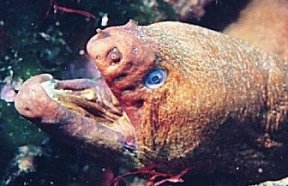 Morays are nocturnal animals that inhabit the waters of New Zealand in the
Pacific, as well as the Indian and Atlantic oceans. They live in caves and rocky reefs.
Morays are nocturnal animals that inhabit the waters of New Zealand in the
Pacific, as well as the Indian and Atlantic oceans. They live in caves and rocky reefs.
There are about 100 species identified by scientists, these range in size from 2-10 feet or 60cm up to around 3 mts. The largest is the giant moray that reaches 10 feet in length and weighs between 35kg's or 75 lbs to aroung 45kg's or 100lbs.
Morays have muscular, deep snake-like bodies. A large mouth with extremely sharp conical (cone shaped) teeth, aided by powerful jaws. They have thick skin and no scales, but a layer of mucus covers the body and protects the skin from germs and parasites.
There are five species of moray in New Zealand waters and their coloured patterns provide the best way of identifying them. They are.....
- Yellow Moray: (Gymnothorax prasinus) This one being the most common or wide spred. Yellow to a silght greenish colour.
- Grey Moray: (Gymnothorax nubilus) This one is a blue to grey colour with irregular darker markings covering the entire body.
- Speckled Moray: (Gymnothorax obesus) These one is dark brown in colour with smaller light spekles over the whole body. This species has a notably shorter and blunter head than the other four.
- Mottled Moray: (Gymnothorax prionodon) This one is brown with a slight mottled arrangement of light spots unevenly spaced over it's length.
- Mosaic Moray: (Enchelycore ramosus) This species is a Blue grey to a pale brown colour flecked with dark brown and being overlaid with a large wider network of darker brown colouring. This species has larger jaws and teeth than the other four.
These colour patterns help to camouflage them in their reef habitat.
Because morays keep their mouths open almost all of the time, the insides of their mouths are camouflaged also. The more common morays around New Zealand reefs include the spotted and green morays.
These fish are also missing the two sets of fins that are normally found on the belly. Instead, they have one long dorsal fin that begins on the head and curves around and connects with the short caudal fin (tail fin).
The moray has poor eyesight but a very good sense of smell. Like most fish, it has two nostrils on each side of its face.
Because it is a night hunter with poor eyesight, the moray relies on its keen sense of smell to locate prey such as octopus, small fish, shrimps, crabs, barnacles and crayfish hiding within a reef.
The Moray eel eat by biting big chunks out of its prey, much like the barracuda.
The Moray eel has another eel around New Zealand that would look very similar, this would be the conger eel.